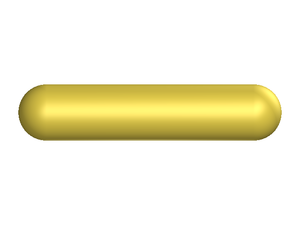Hard spherocylinders: Difference between revisions
Carl McBride (talk | contribs) m (Added short section on the minimum distance.) |
Carl McBride (talk | contribs) (Added some structure to the article.) |
||
| Line 2: | Line 2: | ||
[[Image:spherocylinder_purple.png|thumb|right]] | [[Image:spherocylinder_purple.png|thumb|right]] | ||
The '''hard spherocylinder''' model consists on an impenetrable cylinder, capped at both ends | The '''hard spherocylinder''' model consists on an impenetrable cylinder, capped at both ends | ||
by hemispheres whose diameters are the same as the diameter of the cylinder. | by hemispheres whose diameters are the same as the diameter of the cylinder. The hard spherocylinder model | ||
has been studied extensively because of its propensity to form both [[Nematic phase | nematic]] and [[Smectic phases | smectic]] [[Liquid crystals | liquid crystalline]] phases. One of the first simulations of hard spherocylinders was in the classic work of Jacques Vieillard-Baron (Ref. 1). | |||
==Volume== | |||
The molecular volume of the spherocylinder is given by | The molecular volume of the spherocylinder is given by | ||
| Line 11: | Line 13: | ||
The minimum distance between two spherocylinders can be calculated using an algorithm published by Vega and Lago (Ref. 1). The [[Source code for the minimum distance between two rods | source code can be found here]]. Such an algorithm is essential in, for example, a [[Monte Carlo]] simulation, in order to check for overlaps between two sites. | The minimum distance between two spherocylinders can be calculated using an algorithm published by Vega and Lago (Ref. 1). The [[Source code for the minimum distance between two rods | source code can be found here]]. Such an algorithm is essential in, for example, a [[Monte Carlo]] simulation, in order to check for overlaps between two sites. | ||
#[http://dx.doi.org/10.1016/0097-8485(94)80023-5 Carlos Vega and Santiago Lago "A fast algorithm to evaluate the shortest distance between rods", Computers & Chemistry '''18''' pp. 55-59 (1994)] | #[http://dx.doi.org/10.1016/0097-8485(94)80023-5 Carlos Vega and Santiago Lago "A fast algorithm to evaluate the shortest distance between rods", Computers & Chemistry '''18''' pp. 55-59 (1994)] | ||
==Virial coefficients== | |||
:''Main article: [[Hard spherocylinders: virial coefficients]]'' | |||
==Phase diagram== | |||
:''Main aritcle: [[Phase diagram of the hard spherocylinder model]]'' | |||
==See also== | ==See also== | ||
*[[Charged hard spherocylinders]] | *[[Charged hard spherocylinders]] | ||
==References== | ==References== | ||
#[http://dx.doi.org/10. | #[http://dx.doi.org/10.1080/00268977400102161 Jacques Vieillard-Baron "The equation of state of a system of hard spherocylinders", Molecular Physics '''28''' pp. 809-818 (1974)] | ||
[[Category: Models]] | [[Category: Models]] | ||
Revision as of 12:07, 23 July 2008

The hard spherocylinder model consists on an impenetrable cylinder, capped at both ends by hemispheres whose diameters are the same as the diameter of the cylinder. The hard spherocylinder model has been studied extensively because of its propensity to form both nematic and smectic liquid crystalline phases. One of the first simulations of hard spherocylinders was in the classic work of Jacques Vieillard-Baron (Ref. 1).
Volume
The molecular volume of the spherocylinder is given by
where is the length of the cylindrical part of the spherocylinder and is the diameter.
Minimum distance
The minimum distance between two spherocylinders can be calculated using an algorithm published by Vega and Lago (Ref. 1). The source code can be found here. Such an algorithm is essential in, for example, a Monte Carlo simulation, in order to check for overlaps between two sites.
Virial coefficients
- Main article: Hard spherocylinders: virial coefficients
Phase diagram
- Main aritcle: Phase diagram of the hard spherocylinder model


